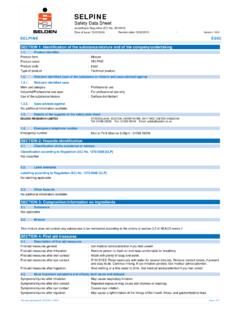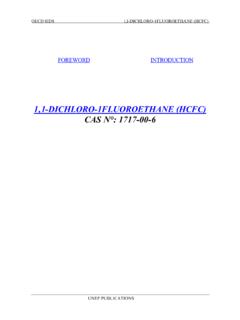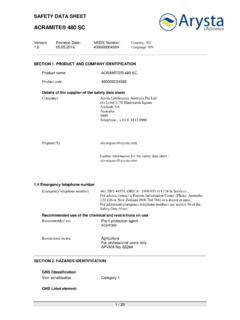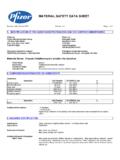Transcription of Bayer Environmental Science - Safeguard Pest Control
1 Bayer Environmental Science SAFETY DATA SHEET according to Regulation (EC) No. 1907/2006 FICAM D 1/10 Version 9 / GB Revision Date: 102000001385 Print Date: SECTION 1: IDENTIFICATION OF THE SUBSTANCE/MIXTURE AND OF THE COMPANY/UNDERTAKING Product identifier Trade name FICAM D Product code (UVP) 05936500 Relevant identified uses of the substance or mixture and uses advised against Use Insecticide Details of the supplier of the safety data sheet Supplier Bayer Environmental Science 230 Cambridge Science Park Milton Road Cambridge Cambridgeshire CB4 0WB United Kingdom Telephone 00800-1214 9451 Telefax +44(0)1223 426240 Responsible Department Email: Emergency telephone no. Emergency telephone no. 0800-220876 (UK 24 hr) +44(0)1635-563000 (Overseas 24 hr) SECTION 2: HAZARDS IDENTIFICATION Classification of the substance or mixture Classification in accordance with Regulation (EC) No 1272/2008 on classification, labelling and packaging of substances and mixtures, as amended.
2 Chronic aquatic toxicity: Category 2 H411 Toxic to aquatic life with long lasting effects. Label elements Labelling in accordance with Regulation (EC) No 1272/2008 on classification, labelling and packaging of substances and mixtures, as amended. Hazard label for supply/use required. Hazardous components which must be listed on the label: Bendiocarb Hazard statements H411 Toxic to aquatic life with long lasting effects. EUH401 To avoid risks to human health and the environment, comply with the instructions for use. Bayer Environmental Science SAFETY DATA SHEET according to Regulation (EC) No. 1907/2006 FICAM D 2/10 Version 9 / GB Revision Date: 102000001385 Print Date: Precautionary statements P501 Dispose of contents/container to a licensed hazardous-waste disposal contractor or collection site except for empty clean containers which can be disposed of as non-hazardous waste. Other hazards No other hazards known. SECTION 3: COMPOSITION/INFORMATION ON INGREDIENTS Mixtures Chemical nature Dustable powder (DP) Bendiocarb 1,25 % w/w Hazardous components Hazard statements according to Regulation (EC) No.
3 1907/2006 Name CAS-No. / EC-No. / REACH Reg. No. Classification Conc. [%] Regulation (EC) No 1272/2008 Bendiocarb 22781-23-3 245-216-8 Acute Tox. 3, H331 Acute Tox. 3, H301 Acute Tox. 3, H311 Aquatic Acute 1, H400 Aquatic Chronic 1, H410 Talc 14807-96-6 238-877-9 Not classified > Further information For the full text of the H-Statements mentioned in this Section, see Section 16. SECTION 4: FIRST AID MEASURES Description of first aid measures General advice Move out of dangerous area. Place and transport victim in stable position (lying sideways). Remove contaminated clothing immediately and dispose of safely. Inhalation Move to fresh air. Keep patient warm and at rest. Call a physician or poison Control center immediately. Skin contact Wash off thoroughly with plenty of soap and water, if available with polyethyleneglycol 400, subsequently rinse with water. If symptoms persist, call a physician. Eye contact Rinse immediately with plenty of water, also under the eyelids, for at least 15 minutes.
4 Remove contact lenses, if present, after the first 5 minutes, then continue rinsing eye. Get medical attention if irritation develops and persists. Bayer Environmental Science SAFETY DATA SHEET according to Regulation (EC) No. 1907/2006 FICAM D 3/10 Version 9 / GB Revision Date: 102000001385 Print Date: Ingestion Call a physician or poison Control center immediately. Rinse mouth. Induce vomiting only, if: 1. patient is fully conscious, 2. medical aid is not readily available, 3. a significant amount (more than a mouthful) has been ingested and 4. time since ingestion is less than 1 hour. (Vomit should not get into the respiratory tract.) Most important symptoms and effects, both acute and delayed Symptoms Local:, The product causes irritation of eyes, skin and mucous membranes. Systemic:, Bradycardia, Sweating, Convulsions, Nausea, Lachrymation, Salivation, Vomiting, Diarrhoea, Miosis, Hypotension, Bronchial hypersecretion, Myoclonus, Respiratory paralysis, Somnolence, Coma, Respiratory failure, Hypothermia, Fibrillation, Spasm Indication of any immediate medical attention and special treatment needed Risks This product is a cholinesterase inhibitor carbamate.
5 Treatment Systemic treatment: Initial treatment: symptomatic. In case of ingestion a gastric lavage within the first hour after ingestion and after intubation only with consecutive application of activated charcoal and sodium sulphate should be performed. In case of convulsions, a benzodiazepine ( diazepam) should be given according to standard regimens. Keep respiratory tract clear. Oxygen or artificial respiration if needed. The following antidotes are generally accepted: atropin and oximes. Recovery is spontaneous and without sequelae. SECTION 5: FIREFIGHTING MEASURES Extinguishing media Suitable Use water spray, alcohol-resistant foam, dry chemical or carbon dioxide. Unsuitable High volume water jet Special hazards arising from the substance or mixture Dangerous gases are evolved in the event of a fire., In common with all other methyl carbamates, bendiocarb will liberate strongly lachrymatory and very toxic methyl isocyanate when heated above it's decomposition temperature which for bendiocarb is > 125 deg C.
6 Methyl isocyanate has a very low flash point and will be readily consumed in a fire. Since methyl isocyanate readily decomposes in contact with water, all decompositions are best extinguished with water. Advice for firefighters Special protective equipment for fire-fighters In the event of fire and/or explosion do not breathe fumes. In the event of fire, wear self-contained breathing apparatus. Further information Contain the spread of the fire-fighting media. Do not allow run-off from fire fighting to enter drains or water courses. Bayer Environmental Science SAFETY DATA SHEET according to Regulation (EC) No. 1907/2006 FICAM D 4/10 Version 9 / GB Revision Date: 102000001385 Print Date: SECTION 6: ACCIDENTAL RELEASE MEASURES Personal precautions, protective equipment and emergency procedures Precautions Avoid dust formation. Avoid contact with spilled product or contaminated surfaces. Use personal protective equipment. Remove all sources of ignition.
7 Environmental precautions Do not allow to get into surface water, drains and ground water. Methods and materials for containment and cleaning up Methods for cleaning up Use mechanical handling equipment. Clean contaminated floors and objects thoroughly, observing Environmental regulations. Collect and transfer the product into a properly labelled and tightly closed container. Additional advice Check also for any local site procedures. Reference to other sections Information regarding safe handling, see section 7. Information regarding personal protective equipment, see section 8. Information regarding waste disposal, see section 13. SECTION 7: HANDLING AND STORAGE Precautions for safe handling Advice on safe handling Avoid dust formation. Use only in area provided with appropriate exhaust ventilation. For personal protection see section 8. Advice on protection against fire and explosion Dust may form explosive mixture in air. Keep away from heat and sources of ignition.
8 Hygiene measures Avoid contact with skin, eyes and clothing. Keep working clothes separately. Wash hands before breaks and immediately after handling the product. Remove soiled clothing immediately and clean thoroughly before using again. Garments that cannot be cleaned must be destroyed (burnt). Conditions for safe storage, including any incompatibilities Requirements for storage areas and containers Keep containers tightly closed in a dry, cool and well-ventilated place. Store in original container. Store in a place accessible by authorized persons only. Protect from frost. Keep away from direct sunlight. Advice on common storage Keep away from food, drink and animal feedingstuffs. Storage stability Other data Becomes brownish during storage. Specific end uses Refer to the label and/or leaflet. SECTION 8: EXPOSURE CONTROLS/PERSONAL PROTECTION Control parameters Components CAS-No. Control parameters Update Basis Bendiocarb 22781-23-3 mg/m3 OES BCS* Bayer Environmental Science SAFETY DATA SHEET according to Regulation (EC) No.
9 1907/2006 FICAM D 5/10 Version 9 / GB Revision Date: 102000001385 Print Date: (TWA) Talc (Respirable dust.) 14807-96-6 1 mg/m3 (TWA) 12 2011 EH40 WEL *OES BCS: Internal Bayer CropScience "Occupational Exposure Standard" Exposure controls Refer to COSHH assessment ( Control of Substances Hazardous to Health (Amendment) Regulations 2004). Engineering controls should be used in preference to personal protective equipment wherever practicable. Refer also to COSHH Essentials. Personal protective equipment In normal use and handling conditions please refer to the label and/or leaflet. In all other cases the following recommendations would apply. Respiratory protection Wear respirator with a particle filter mask (protection factor 4) conforming to European norm EN149 FFP1 or equivalent. Respiratory protection should only be used to Control residual risk of short duration activities, when all reasonably practicable steps have been taken to reduce exposure at source containment and/or local extract ventilation.
10 Always follow respirator manufacturer's instructions regarding wearing and maintenance. Hand protection Please observe the instructions regarding permeability and breakthrough time which are provided by the supplier of the gloves. Also take into consideration the specific local conditions under which the product is used, such as the danger of cuts, abrasion, and the contact time. Wash gloves when contaminated. Dispose of when contaminated inside, when perforated or when contamination on the outside cannot be removed. Wash hands frequently and always before eating, drinking, smoking or using the toilet. Material Nitrile rubber Rate of permeability > 480 min Glove thickness > mm Protective index Class 6 Directive Protective gloves complying with EN 374. Eye protection Wear goggles (conforming to EN166, Field of Use = 5 or equivalent). Skin and body protection Wear standard coveralls and Category 3 Type 5 suit. If there is a risk of significant exposure, consider a higher protective type suit.









